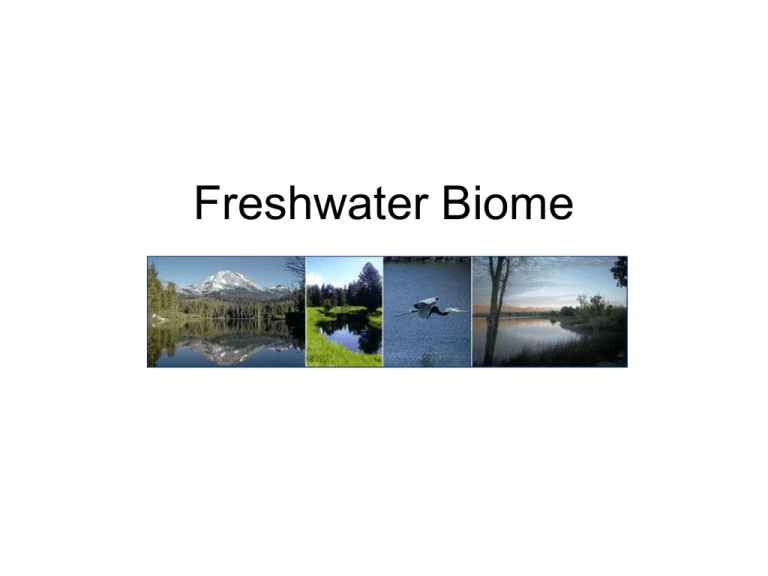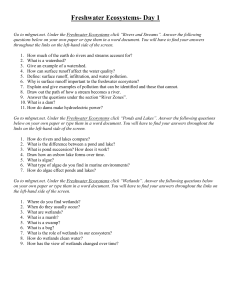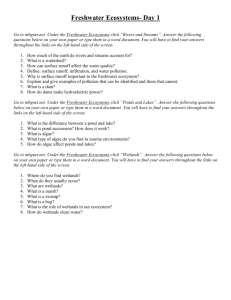freshwater_biome_1
advertisement

Freshwater Biome Freshwater • Freshwater is defined as having a low salt concentration — usually less than 1%. • Plants and animals in freshwater regions are adjusted to the low salt content and would not be able to survive in areas of high salt concentration (i.e., ocean). Ponds and Lakes • Ponds and lakes may have limited species diversity since they are often isolated from one another and from other water sources like rivers and oceans. • Lakes and ponds are divided into four different “zones” which are usually determined by depth and distance from the shoreline. Life Zones in Freshwater Littoral Zone • The topmost zone near the shore of a lake or pond --this zone is the warmest since it is shallow and can absorb more of the Sun's heat. • It sustains a fairly diverse community, which can include several species of algae (like diatoms), rooted and floating aquatic plants, grazing snails, clams, insects, crustaceans, fishes, and amphibians. • In the case of the insects, such as dragonflies and midges, only the egg and larvae stages are found in this zone. The vegetation and animals living in the littoral zone are food for other creatures such as turtles, snakes, and ducks. Limnetic Zone • The near-surface open water surrounded by the littoral zone—it is well-lighted (like the littoral zone) and is dominated by plankton, both phytoplankton and zooplankton. • Plankton are small organisms that play a crucial role in the food chain. Without aquatic plankton, there would be few living organisms in the world, and certainly no humans. A variety of freshwater fish also occupy this zone. Profundal Zone • the deep-water part of the lake/pond. • This zone is much colder and denser than the other two. Little light penetrates all the way through the limnetic zone into the profundal zone. • The fauna are heterotrophs, meaning that they eat dead organisms and use oxygen for cellular respiration. Benthic Zone • Bottom of a pond or lake • Inhabitants are decomposers, insect larvae and clams. • Dead and decaying organisms (detris) settle to the bottom Eutrophication • An increase in the amount of nutrients in an aquatic ecosystem. • As the amount of plants and algae grows, the number of bacteria feeding on decaying organisms also grows. These bacteria use the oxygen in the lake, reducing oxygen for others. Streams and rivers These are bodies of flowing water moving in one direction. The temperature is cooler at the source than it is at the mouth. The water is also clearer, has higher oxygen levels, and freshwater fish such as trout and heterotrophs can be found there. • Towards the middle part of the stream/river, the width increases, as does species diversity — numerous aquatic green plants and algae can be found. • Toward the mouth of the river/stream, the water becomes murky from all the sediments that it has picked up upstream, decreasing the amount of light that can penetrate through the water. • Since there is less light, there is less diversity of flora, and because of the lower oxygen levels, fish that require less oxygen, such as catfish and carp, can be found. Wetlands Wetlands Wetlands • Wetlands are areas where water covers the soil, or is present either at or near the surface of the soil all year or for varying periods of time during the year, including during the growing season. Wetland Diversity • Wetlands vary widely because of regional and local differences in soils, topography, climate, hydrology, water chemistry, vegetation, and other factors, including human disturbance. Indeed, wetlands are found from the tundra to the tropics and on every continent except Antarctica. Types of wetlands • coastal or tidal wetlands and inland or non-tidal wetlands. Life Zones in Oceans Coastal Wetlands of USA Found along the Atlantic, Pacific, Alaskan, and Gulf coasts. • They are closely linked to our nation's estuaries, where sea water mixes with fresh water to form an environment of varying salinities. The salt water and the fluctuating water levels (due to tidal action) combine to create a rather difficult environment for most plants. • Consequently, many shallow coastal areas are unvegetated mud flats or sand flats. • Mangrove swamps, with salt-loving shrubs or trees, are common in tropical climates, such as in southern Florida and Puerto Rico. Inland wetlands • Most common on floodplains along rivers and streams (riparian wetlands), in isolated depressions surrounded by dry land (for example, playas, basins, and "potholes"), along the margins of lakes and ponds, and in other low-lying areas where the groundwater intercepts the soil surface or where precipitation sufficiently saturates the soil (vernal pools and bogs). • Inland wetlands include marshes and wet meadows dominated by herbaceous plants, swamps dominated by shrubs, and wooded swamps dominated by trees. Wetlands are among the most productive ecosystems in the world, comparable to rain forests and coral reefs. "biological supermarkets" • They provide great volumes of food that attract many animal species. • These animals use wetlands for part of or all of their life-cycle. • Dead plant leaves and stems break down in the water to form small particles of organic material called "detritus." This enriched material feeds many small aquatic insects, shellfish, and small fish that are food for larger predatory fish, reptiles, amphibians, birds, and mammals. Watersheds help the ecosystem Scientists are beginning to realize that atmospheric maintenance may be an additional wetlands function • Wetlands store carbon within their plant communities and soil instead of releasing it to the atmosphere as carbon dioxide. • Thus wetlands help to moderate global climate conditions. Water Quality and Hydrology • Wetlands have important filtering capabilities for intercepting surface- water runoff from higher dry land before the runoff reaches open water. • As the runoff water passes through, the wetlands retain excess nutrients and some pollutants, and reduce sediment that would clog waterways and affect fish and amphibian egg development Dead Zones Zoneshttp://www.nnvl.noaa.gov/MediaHome.php?MediaTypeID=2 • Hypoxic zones are areas in the ocean of such low oxygen concentration that animal life suffocates and dies, and as a result are sometimes called "dead zones." One of the largest dead zones forms in the Gulf of Mexico every spring. Flood Protection • Wetlands function as natural sponges that trap and slowly release surface water, rain, snowmelt, groundwater and flood waters. • Trees, root mats, and other wetland vegetation also slow the speed of flood waters and distribute them more slowly over the floodplain. • This combined water storage and braking action lowers flood heights and reduces erosion. Wetlands within and downstream of urban areas counteract the greatly increased rate and volume of surface-water runoff from pavement and buildings. Shoreline Erosion • The ability of wetlands to control erosion is so valuable that some states are restoring wetlands in coastal areas to buffer the storm surges from hurricanes and tropical storms. • Wetlands at the margins of lakes, rivers, bays, and the ocean protect shorelines and stream banks against erosion. • Wetland plants hold the soil in place with their roots, absorb the energy of waves, and break up the flow of stream or river currents Threats to wetland Too many people Industrial pollution Runoff Fish and Wildlife Habitat More than one-third of the United States‘ threatened and endangered species live only in wetlands, and nearly half use wetlands at some point in their lives. Many other animals and plants depend on wetlands for survival. Natural Products for Our Economy We use a wealth of natural products from wetlands, including fish and shellfish, blueberries, cranberries, timber, and wild rice, as well as medicines that are derived from wetland soils and plants. Recreation and Aesthetics Wetlands have recreational, historical, scientific, and cultural values. More than half of all U.S. adults (98 million) hunt, fish, birdwatch or photograph wildlife. Wetlands Protection • The federal government protects wetlands through regulations (like Section 404 of the Clean Water Act), economic incentives and disincentives (for example, tax deductions for selling or donating wetlands to a qualified organization and the "Swampbuster" provisions of the Food Security Act), cooperative programs, and acquisition (for example, establishing national wildlife refuges). • You can find out more about these mechanisms by calling the Wetlands Hotline (1-800-832-7828). How Can You Make a Difference? • Get involved find out where wetlands exist near your home, try to learn more about them, and support educational efforts. • Support wetlands and watershed protection initiatives by public agencies and private organizations. • Purchase federal duck stamps from your local post office to support wetland acquisition. • Encourage neighbors, developers, and state and local governments to protect the function and value of wetlands in your watershed. • Learn more about wetland restoration activities in your area; seek and support opportunities to restore degraded wetlands.





